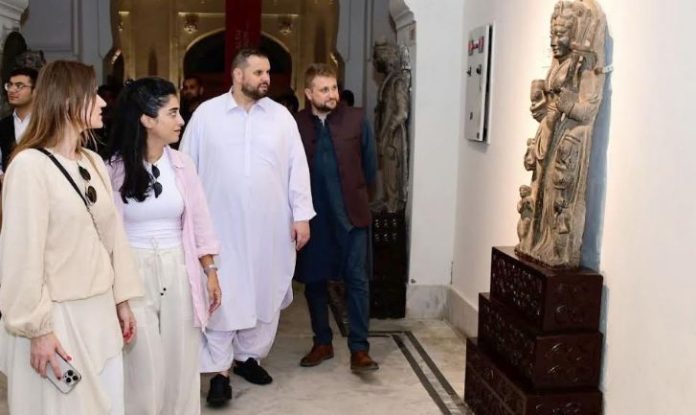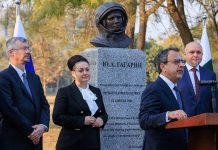PESHAWAR, OCT 06 (DNA): The ancient city of Peshawar, with its vibrant bazaars, ornate havelis, Gandhara civilization and the scent of history lingering in its narrow alleys, welcomed an extraordinary group of visitors this week.
A delegation of ambassadors and dignitaries from the European Union (EU) embarked on a rare cultural journey through the heart of one of South Asia’s oldest living cities, which was an experience that turned into a celebration of heritage, hospitality, and human connection.
Amid the golden hues of autumn sunlight, the delegation was greeted by senior officials of the Khyber Pakhtunkhwa Directorate of Archaeology and Museums, who led them on an immersive tour through the city’s treasured historic sites.
The visit, a part of ongoing cultural diplomacy efforts, aimed to highlight Peshawar’s centuries-old legacy as a crossroads of civilizations.
Their first stop was the iconic Gor Khatri, a site layered with archaeological wonders dating back nearly 3,000 years.
Standing on the ancient mound, once a Mughal caravanserai and before that a Buddhist monastery, the ambassadors were visibly moved by the weight of time etched into the weathered stones beneath their feet.
Walking the Cultural Heritage Trail, which winds through 500 meters of Peshawar’s Old City, the visitors found themselves transported to a different era.
The trail, painstakingly restored by KP’s archaeology department, meanders past over 85 restored buildings from the Mughal, Sikh, and British periods. Each structure whispers stories of merchants, poets, and pilgrims who once passed through these streets.
At the heart of this journey lies Sethi House, which is a masterpiece of architecture and craftsmanship built in the late 19th century by a wealthy trading family originally from Jhelum.
Tucked away in the serene alley of Mohallah Sethian, this majestic haveli stunned the delegation with its fusion of Central Asian, Mughal, and British colonial design elements.
From intricately carved wooden balconies to hidden courtyards and water fountains, Sethi House tells a story not only of affluence but of artistic ambition. “This is not just a building,” one ambassador remarked, “it is poetry carved in wood.”
The visitors marveled at how the house’s architectural features such as natural ventilation, airy courtyards, and smart use of space echoed principles of sustainable design long before the modern term existed. Its construction, begun in 1835 by Sethi Karim Bakhsh and completed nearly five decades later, remains a testament to generational craftsmanship and vision.
Another highlight was the Peshawar Museum, originally built in 1906 in memory of Queen Victoria. Here, the ambassadors explored the world-renowned Buddha Gallery, where detailed biographical panels trace Lord Buddha’s life from birth to enlightenment.
With its Indo-British architectural fusion and treasured collections from the Gandhara civilization, the museum offered a profound look into the region’s spiritual and artistic heritage. “You don’t just observe history here,” said another delegate. “You feel it.”
Beyond the architecture and antiquities, it was the people of Peshawar who truly captured the hearts of the visitors. Local guides, artisans, and community members shared stories of their ancestors and the living traditions that still define their city today.
The famous Khattak dance impressed the visitors. The tour concluded with a scenic bus ride through the bustling streets, past Ghanta Ghar and the colorful stalls of Bazaar-e-Kalaan, where the aroma of spices such as Chappli Kabab, Matton Karahi and sounds of traders have remained unchanged for generations.
In a heartfelt gesture, the Khyber Pakhtunkhwa Culture and Tourism Authority presented each guest with a handcrafted souvenir, symbolizing the warmth and generosity of the local people.
The ambassadors, visibly touched, expressed deep admiration for the city’s cultural depth and timeless charm.

















